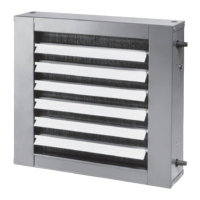120 UNT-SVX07B-EN
Diagnostics
Battery Installation
WARNING
Prevent Injury!
Batteries can explode or leak and cause burns if installed backwards, disassembled, charged, or
exposed to water, fire, or high temperature.
WARNING
Prevent Injury!
Keep away from small children. If swallowed, contact your local poison control center
immediately.
6. Observe the polarity indicators that are molded into the cover.
7. Install two batteries (of the type specified in “Battery Type,” p. 119 ) in the battery-holding slot
that is molded into
the sensor cover.
The sensor has been designed to prevent damage if the batteries are installed backwards, to reduce
the p
otential for injury.
Manual Association
Before attempting manual or automatic association, the receiver must indicate readiness to
associate (one blink pattern of LED3 on receiver). Refer to “Observing the Receiver for Readiness
to Associate,” p. 69.
At any time, the manual association method can be used to associate the receiver with the sensor.
If an association was previously established between a receiver and a sensor and needs to be re-
established, the manual association process may be used. If an association has not yet been
established, the automatic association process is recommended (see “Associating the Sensor to
the Receiver,” p. 70).
8. Using a small screwdriver, set the three
rotary address switches (Figure 19, p. 69, locations S1,
S2, S3) on the receiver to an address between 001 and 999.
Notes:
• An
address can be changed without powering down the receiver or sensor.
• An address can be changed at any time after initial association has been established.
9. Set the three rotary address switches (Figure 19, p. 69, locations S1, S2, S3) on the sensor to
the same address as the receiver.
10. Record the address and location of the rece
iver and sensor pair.
• Af
ter verifying that the receiver and sensor are powered up, press the Test button on the
sensor to establish that the signal strength (“Testing Signal Strength,” p. 117) and the battery
life “Testing Battery Status,” p. 118) are adequate for proper functioning.
Disassociation
The receiver disassociates from the sensor (by removing all stored association information),
conducts a channel scan, and restarts itself, if any of the following are true:
• The receiver address is changed from its current setting (001–999)
• The receiver receives a disassociation notification from
its associated sensor
• The receiver does not receive a communication
from its associated sensor within 50 minutes.
• The sensor and receiver are associate
d and communicating at the time the sensor is set to 000
and the Test button is pressed.
Note: A disassociat
ed sensor will transit an association request every 10 minutes.

